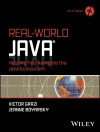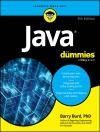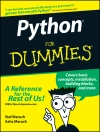NEW LANGUAGE VISUALIZES PROGRAM ABSTRACTIONS CLEARLY AND
PRECISELY
Popular software modelling notations visualize implementation
minutiae but fail to scale, to capture design abstractions, and to
deliver effective tool support. Tailored to overcome these
limitations, Codecharts can elegantly model roadmaps and blueprints
for Java, C++, and C# programs of any size clearly, precisely, and
at any level of abstraction. More practically, significant
productivity gains for programmers using tools supporting
Codecharts have been demonstrated in controlled experiments.
Hundreds of figures and examples in this book illustrate how
Codecharts are used to:
* Visualize the building-blocks of object-oriented design
* Create bird’s-eye roadmaps of large programs with minimal
symbols and no clutter
* Model blueprints of patterns, frameworks, and other design
decisions
* Be exactly sure what diagrams claim about programs and reason
rigorously about them
Tools supporting Codecharts are also shown here to:
* Recover design from plain Java and visualize the program’s
roadmap
* Verify conformance to design decision with a click of a
button
This classroom-tested book includes two main parts:
Practice (Part I) offers experienced programmers,
software designers and software engineering students practical
tools for representing and communicating object-oriented design. It
demonstrates how to model programs, patterns, libraries, and
frameworks using examples from JDK, Java 3D, JUnit, JDOM,
Enterprise Java Beans, and the Composite, Iterator, Factory Method,
Abstract Factory, and Proxy design patterns.
Theory (Part II) offers a mathematical foundation for
Codecharts to graduate students and researchers studying software
design, modelling, specification, and verification. It defines a
formal semantics and a satisfies relation for design
verification, and uses them to reason about the relations between
patterns and programs (e.g., ’java.awt implements Composite’ and
’Factory Method is an abstraction of Iterator’).
Innehållsförteckning
Preface.
Acknowledgements.
Guide to the Reader.
Codecharts.
Propositions.
Prologue.
1. Motivation.
2. Design Description Languages.
2.1 Theory Versus Practice.
2.2 Decidability.
2.3 Abstraction.
2.4 Elegance.
3. An Overview of Codecharts.
3.1 Object-Orientation.
3.2 Visualization.
3.3 Rigour.
3.4 Automated Verifiability.
3.5 Scalability.
3.6 Genericity.
3.7 Minimality.
3.8 Information Neglect.
4. UML Versus Codecharts.
5. Historical Notes.
PART I: Practice.
6. Modelling Small Programs.
6.1 Modelling Individual Classes.
6.2 Modelling Individual Methods.
6.3 Modelling Properties.
6.4 Modelling Implementation Minutia.
6.5 Modelling Simple Relations.
6.6 Modelling Indirect Relations.
6.7 Subtyping.
7. Modelling Large Programs.
7.1 Modelling Sets of Classes.
7.2 Modelling Total Relations Between Sets.
7.3 Modelling Sets of Methods (Clans).
7.4 Modelling Isomorphic Relations.
7.5 Modelling Sets of Methods (Tribes).
7.6 Modelling Class Hierarchies.
7.7 Modelling Methods in Hierarchies.
7.8 Modelling Properties of Sets.
7.9 Case Study: Total Versus. Isomorphic.
7.10 Case Study: JDOM.
7.11 Case Study: Java 3D.
8. Modelling Industry-Scale Programs.
8.1 Modelling Sets of Hierarchies.
8.2 Modelling Sets of Sets of Methods (Clans).
8.3 Modelling Sets of Sets of Methods (Tribes).
8.4 Modelling Total Relations Revisited.
8.5 Modelling Isomorphic Relations Revisited.
9. Modelling Design Motifs.
10. Modelling Application Frameworks.
10.1 Case Study: Enterprise Java Beans.
10.2 Case Study: JUnit.
11. Modelling Design Patterns.
11.1 Case Study: The Composite Pattern.
11.2 Case Study: The Iterator Pattern.
11.3 Case Study: The Factory Method Pattern.
11.4 Case Study: The Abstract Factory Pattern.
11.5 Concluding Remarks.
12. Modelling Early Design Revisited.
13. Advanced Modelling Techniques.
13.1 Ad Hoc Symbols.
13.2 Modelling Information Hiding.
PART II: Theory.
14. Abstract Semantics.
14.1 Finite Structures.
14.2 Abstract Semantics Functions.
14.3 Design Models.
14.4 Program Modelling Revisited.
15. Verification.
15.1 Verifying Closed Specifications.
15.2 Verifying Open Specifications.
15.3 Verifying Pattern Implementations.
15.4 Tool Support for Automated Verification.
16. Schemas.
17. Le PUS3 in Classical Logic.
17.1 Le PUS3 and Class-Z as First-Order Languages.
17.2 Specifications in the Predicate Logic.
17.3 The Axioms of Class-Based Programs.
18. Reasoning about Charts.
Appendix I: The Gang of Four Companion.
Appendix II: Formal Definitions.
Appendix III: UML Quick Reference.
References.
Index.
Om författaren
AMNON H. EDEN, Ph D, is a computer scientist with the School
of Computer Science and Electronic Engineering at the University of
Essex and a research fellow at the Center for Inquiry. Dr. Eden has
worked as a programmer and consultant to leading software
companies, chaired the Software Engineering Diploma Programme at
the Tel Aviv College of Management, and served as the associate
editor of Minds and Machines. His publications include an entry in
the Stanford Encyclopedia of Philosophy and articles in
leading software engineering journals.
JONATHAN NICHOLSON, Ph D, earned his doctorate from the
School of Computer Science and Electronic Engineering at the
University of Essex under the co-supervision of Prof. Raymond
Turner and Dr. Eden. His research centres on object-oriented
design, with a focus on the development and implementation of the
logic underlying the language of Codecharts.












